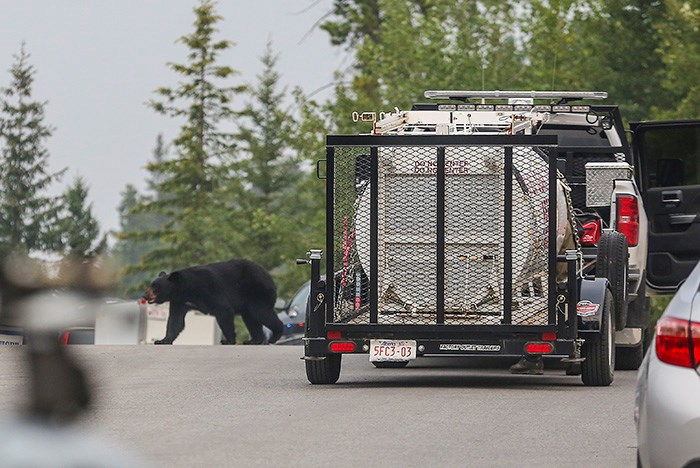CANMORE – A black bear that reportedly got into garbage left out in the Peaks of Grassi neighbourhood has been killed.
The medium-sized male bear, which was relocated about 40 kilometres away last August after getting into garbage in the same neighbourhood, was killed by Fish and Wildlife officers on May 2 after returning to the area where it got a food reward.
The province would not permit the Outlook to interview local Fish and Wildlife officers on the issue, but a spokesperson for Alberta Justice and Solicitor General said the bear’s death came down to a matter of public safety.
“Having a large animal in an urban area is a serious public safety concern, especially when the animal is not shy of humans and even willingly approaches them,” said Dan Laville, communications director for Alberta Justice and Solicitor, in a statement.
“Bears that show this sort of behaviour are at an increased risk to injure or kill someone. For these reasons, officers had to make the difficult choice to put this bear down to prevent future public safety problems.”
In this case, officials with the Town of Canmore’s municipal bylaw enforcement department said there wasn’t enough evidence to charge anyone with leaving garbage out, but tickets were issued for birdfeeders.
"Last week, one of our officers did attend to the bear call with (Fish and Wildlife) and two tickets were issued for birdfeeders that were out between April 1-Nov 30 under the Wildlife Attractant Bylaw," said Michael Orr, bylaw services supervisor for the Town of Canmore.
"I think this serves as a reminder that people should be putting feeders away, using bear proof garbage/recycling bins properly, removing fruit from trees, and keeping attractants from being left out on their property to ensure that wild animals don’t become habituated towards food sources."
In terms of garbage, Orr said they needed a statement from a witness and a willingness to swear in court – but they didn’t have that.
“The bear was in the area, it was reported to be in some trees, it was reported milling around some garbage, but we couldn’t find anything when we were up there,” he said.
“We didn’t find anything that would give us reasonable and probable grounds to be able charge anyone with an offence.”
Sightings of the black bear in the Peaks neighbourhood first came to the attention of Fish and Wildlife officers on April 26. There were reports the bear was eating birdseed on residents’ decks and entered a garage where it accessed a chest freezer.
Traps were set up and Fish and wildlife officers warned people in the neighbourhood to put away any attractants, such as garbage, pet food, bird feeders, recycling and greasy barbecues.
Last year, the black bear was originally attracted to the area due to natural food sources such as buffaloberries and fruit trees, but grew more brazen and accustomed to human food over several days spent in the Peaks neighbourhood. The bruin eventually came across a bag of garbage and made its way inside a garage of a home.
Officials with Bow Valley WildSmart say the fate of this black bear is an example of how bears will return to an area where they’ve been successful in getting human food and garbage.
“It sounds harsh to say, but a fed bear is a dead bear,” said Nick de Ruyter, the group’s program director.
De Ruyter said he hopes the death of the bear so early in the year serves as an immediate lesson for people to make sure there is nothing in their yards that may attract wildlife.
“Once a bear gets a food reward they will keep coming back,” he said.
“Things that may seem unimportant to us, like a bit of bird seed or recycling left out, could potentially be something very serious for bears or another wildlife.”
If bears find a reason to linger in neighbourhoods, de Ruyter said that’s when they get into trouble.
“It’s tricky for houses in the Peaks of Grassi or Silvertip on the edge of habitat patches and corridors, but it’s even more important because bears are wandering along there anyway,” he said.
Canmore has had a wildlife attractant bylaw since spring 2017, allowing fines to be issued against people who attract dangerous wildlife to their yards with garbage, bird seed, pet food, buffalo berries and greasy barbecues – even crabapples.
In Canmore, all bird feeders are prohibited in the community from April 1 to the end of November as a way to prevent bears from feeding on the seeds. The bird feeder prohibition also applies to multi-storey residential development.
Over the past 20 years, the province has destroyed 19 black bears and one grizzly bear in the Bow Valley. The grizzly, a four-year-old male known as number 99, was the one that killed Isabelle Dubé in June 2005 as she jogged near Silvertip.
In addition, 66 black bears and 12 grizzly bears have been moved out of the Bow Valley over the same time frame.
Report a bear, cougar, wolf or any aggressive wildlife in Kananaskis or the Bow Valley to Kananaskis Emergency Services at 403-591-7755.




